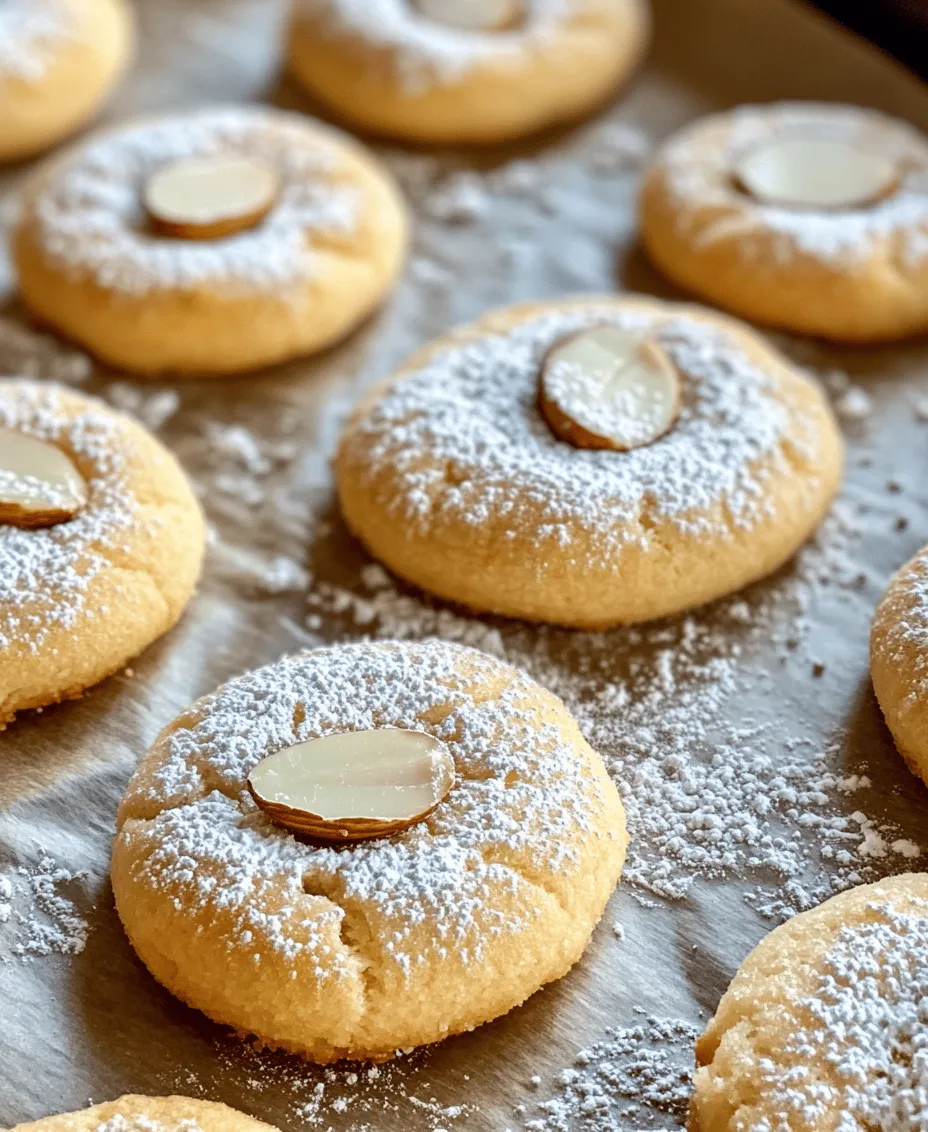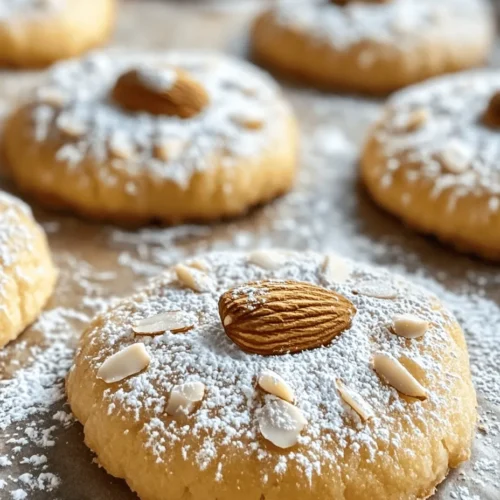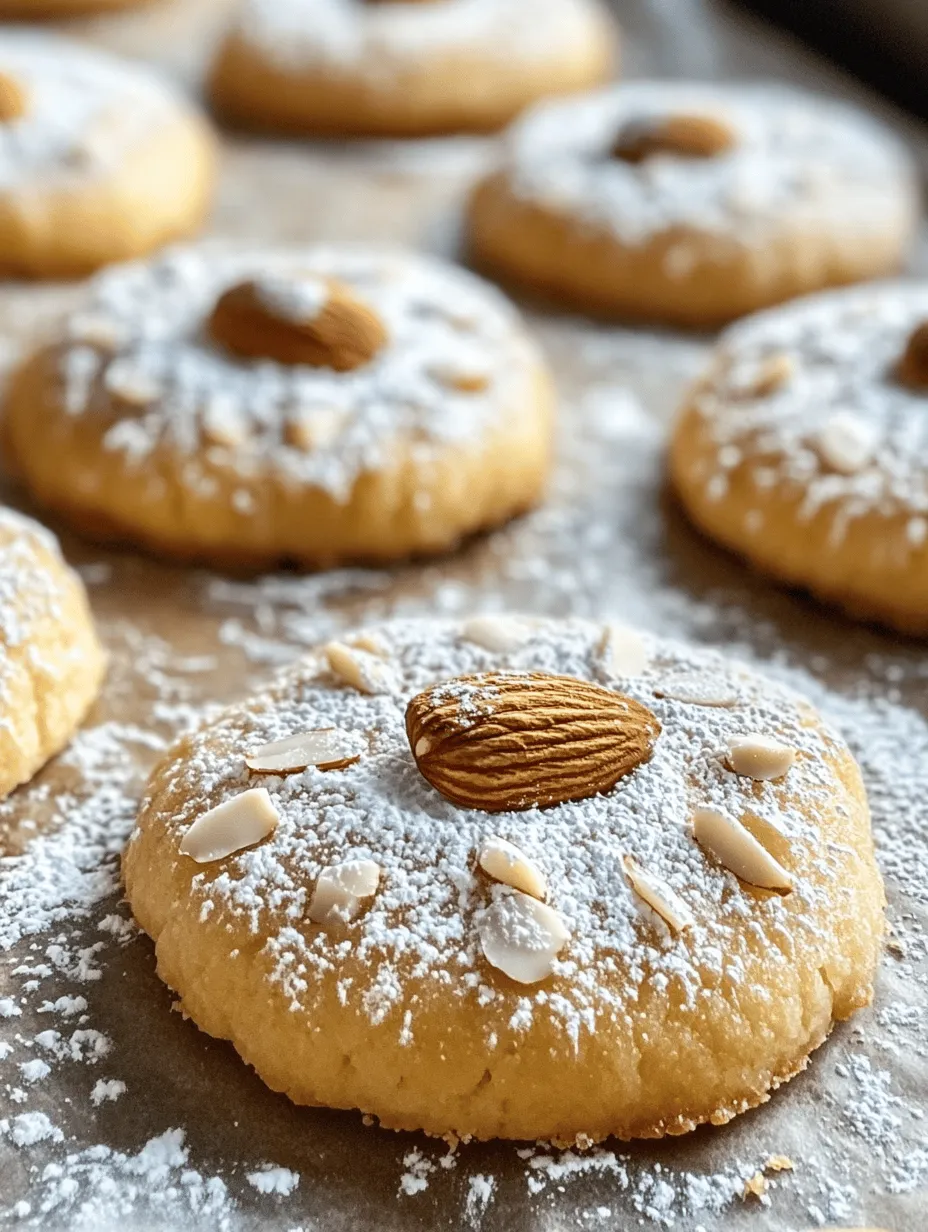Introduction
Welcome to the delightful world of Ghraybeh, a traditional Middle Eastern cookie that embodies simplicity and elegance in every bite. Known for its tender crumb and buttery flavor, Ghraybeh treats are a staple in many households across the Middle East, often enjoyed during special occasions, festive gatherings, and family celebrations. These delicate cookies are not only a treat for the taste buds but also a symbol of hospitality and festivity in Middle Eastern culture, making them a cherished dessert among friends and family alike.
What makes Ghraybeh particularly appealing is its straightforward recipe, requiring minimal ingredients that yield delectable results. Perfect for both novice bakers and seasoned chefs, Ghraybeh cookies are an excellent way to dip your toes into the world of Middle Eastern sweets. Whether you’re looking to impress guests at a gathering or want to indulge in a homemade treat, Ghraybeh offers a charming and satisfying baking experience.
In the following sections, we will explore the origins and history of Ghraybeh, delve into the essential ingredients that make up this beloved cookie, and provide a step-by-step guide to creating your very own batch of these melt-in-your-mouth delights.
Understanding Ghraybeh
Ghraybeh traces its roots to the rich tapestry of Middle Eastern cuisine, with a history that spans centuries. This cookie’s name is derived from the Arabic word for “strange” or “unusual,” reflecting its unique texture and delightful melt-in-the-mouth quality. Ghraybeh is believed to have originated in the Levant region, with variations found in countries such as Lebanon, Syria, and Palestine. Each culture has put its own spin on the recipe, often incorporating specific spices or flavors that reflect local tastes.
Despite these variations, the core essence of Ghraybeh remains the same: a simple, buttery cookie that is both elegant and delicious. The common thread among all Ghraybeh recipes is the reliance on a few basic ingredients, which come together to create a cookie that is both rich in flavor and light in texture. This simplicity is part of what makes Ghraybeh so appealing; it’s a reminder that the best treats often come from the most uncomplicated recipes.
The ingredients typically used in Ghraybeh contribute significantly to its unique texture and flavor profile. The delicate balance of fat, sugar, and flour results in a cookie that is both crumbly and tender, making it a favorite amongst those with a sweet tooth. Ghraybeh is often adorned with a blanched almond, adding a touch of elegance and a subtle nutty flavor that complements the cookie’s buttery base.
For many, Ghraybeh is more than just a cookie; it is a tradition passed down through generations. Families gather to bake Ghraybeh during holidays and celebrations, sharing stories and laughter as they prepare these delightful treats. The act of making Ghraybeh is often as cherished as the cookies themselves, creating lasting memories that span generations.
Ingredients Breakdown
As we embark on the journey of making Ghraybeh, it’s essential to understand the role of each ingredient in crafting these delicious cookies. The beauty of Ghraybeh lies in its simplicity, with just a handful of components that come together to create something truly extraordinary. Here’s a closer look at the essential ingredients that will elevate your Ghraybeh baking experience:
Unsalted Butter
The star of Ghraybeh is undoubtedly unsalted butter. Its rich flavor and creamy texture are crucial to achieving the cookie’s signature melt-in-the-mouth quality. When butter is creamed with sugar, it creates air pockets that help the cookies rise slightly during baking, contributing to their tender crumb. Using unsalted butter allows bakers to control the saltiness of the cookies, ensuring a balanced flavor.
Powdered Sugar
In Ghraybeh, powdered sugar is preferred over granulated sugar for several reasons. Firstly, powdered sugar dissolves more easily, resulting in a smoother batter. This fine texture helps create the cookie’s delicate crumb. Additionally, powdered sugar lends a subtle sweetness without overpowering the buttery flavor. Its light consistency also contributes to the melt-in-your-mouth experience that Ghraybeh is known for.
All-Purpose Flour
All-purpose flour serves as the backbone of Ghraybeh, providing the necessary structure for the cookies. It helps bind the ingredients together while also contributing to the cookie’s texture. The key to achieving the perfect Ghraybeh lies in the flour-to-fat ratio; too much flour can lead to a dry cookie, while too little can result in a crumbly mess. Finding the right balance is essential for creating that perfect melt-in-your-mouth experience.
Salt
While it may seem counterintuitive to add salt to a sweet cookie, a pinch of salt is vital for enhancing the overall flavor profile of Ghraybeh. Salt acts as a flavor enhancer, bringing out the sweetness of the sugar and the richness of the butter. It also helps to balance the flavors, making the cookies more enjoyable to eat. A small amount of salt can elevate the taste of Ghraybeh, ensuring a well-rounded flavor.
Vanilla Extract
Vanilla extract is another critical ingredient that contributes to the aromatic qualities of Ghraybeh. Its warm, sweet fragrance complements the buttery cookies, adding depth to the overall flavor. When combined with the other ingredients, vanilla extract enhances the sensory experience of eating Ghraybeh, making each bite even more delightful.
Blanched Almonds
Traditionally, Ghraybeh cookies are topped with a blanched almond, which serves two purposes: decoration and flavor enhancement. The almond adds a subtle nutty flavor that pairs beautifully with the buttery cookies. Additionally, the visual appeal of the almond on top of each cookie makes Ghraybeh a feast for the eyes as well as the palate.
Optional Powdered Sugar Dusting
For an added touch of sweetness and aesthetic appeal, many bakers opt for a light dusting of powdered sugar on top of the finished Ghraybeh. This not only enhances the cookie’s look but also provides a delightful sweetness that contrasts beautifully with the buttery flavor. While optional, this dusting can elevate your Ghraybeh, making it look and taste even more irresistible.
Step-by-Step Instructions for Perfect Ghraybeh
Now that we have a firm understanding of the ingredients that make up Ghraybeh, it’s time to dive into the step-by-step process of creating these delightful cookies. Follow these instructions closely to ensure that your Ghraybeh turns out perfectly every time.
Preheating the Oven
Before you begin mixing your ingredients, it’s crucial to preheat your oven. Proper oven temperature is critical for successful baking, as it ensures that your cookies cook evenly and achieve the desired texture. Preheat your oven to 350°F (175°C) and allow it to reach the right temperature before placing your Ghraybeh on the baking sheet. This step will help the cookies rise properly and develop a lovely golden color.
By understanding the significance of each ingredient and following the step-by-step instructions, you’re well on your way to creating a batch of Ghraybeh that will delight your taste buds and impress your friends and family. The journey of making these traditional Middle Eastern cookies is not just about the end result; it’s also about the joy of baking and sharing a piece of cultural heritage. Stay tuned for the next part of this recipe, where we will continue with the mixing and baking process, ensuring that your Ghraybeh treats are nothing short of spectacular.

Creaming Butter and Sugar
The foundation of any great cookie lies in the creaming of butter and sugar. This step is crucial for achieving a light and fluffy mixture that will give Ghraybeh its signature texture. Start by placing your softened butter in a large mixing bowl. It’s important that your butter is at room temperature—this allows it to incorporate air more effectively as you mix. Add the granulated sugar to the bowl and, using an electric mixer or a sturdy wooden spoon, beat the two together.
Aim for a pale, creamy consistency, which usually takes about 3-5 minutes of mixing. This process introduces air into the mixture, resulting in cookies that are tender with a delicate crumb. Don’t rush this step; the more air you beat into the mixture, the lighter your cookies will be.
Adding Flavor
Once you have achieved that light and fluffy texture, it’s time to enhance your Ghraybeh with flavor. The traditional flavoring for these cookies often includes a hint of vanilla extract. Pour in about a teaspoon of high-quality pure vanilla extract and mix it in gently. This not only adds warmth and depth to the cookies but also complements the natural flavors of the butter and almond. If you wish to experiment, you can also add a pinch of cardamom or orange blossom water for an exotic twist.
Combining Dry Ingredients
Next, it’s time to combine your dry ingredients. In a separate bowl, whisk together all-purpose flour and a pinch of salt. Whisking is essential here as it aerates the flour and ensures that the salt is evenly distributed throughout. This step helps to avoid any pockets of flour in your dough and guarantees a smooth, even texture in your finished cookies. Slowly add the flour mixture to the creamed butter and sugar, mixing on low speed to avoid a flour explosion.
Forming the Dough
Once your dry ingredients are fully incorporated, it’s important to handle the dough with care to prevent overworking it. Overmixing can lead to tough cookies, which is not what we want for Ghraybeh. Use a spatula or wooden spoon to gently fold the dough until it comes together. You want a soft, pliable dough that holds its shape but isn’t sticky. If the dough feels too soft, you can refrigerate it for about 15-30 minutes, which will make it easier to handle.
Shaping the Cookies
Shaping the cookies is a fun part of the process! To create uniform Ghraybeh, scoop out small portions of dough, about the size of a tablespoon. Roll each portion into a ball between your palms and then gently flatten it into a disc. Uniformity in size is key, as it ensures even baking.
Decorating with Almonds
A hallmark of Ghraybeh is the almond on top. To achieve the perfect look, take a whole blanched almond and press it lightly into the center of each cookie. Be careful not to press too hard; you want the almond to sit snugly without flattening the cookie further. This not only adds visual appeal but also a delightful crunch when you bite into these treats.
Baking
Preheat your oven to 350°F (175°C) and line a baking sheet with parchment paper. Place your shaped cookies on the prepared baking sheet, ensuring they are spaced apart to allow for spreading. Bake the Ghraybeh for about 15-20 minutes, or until the edges are lightly golden. A key sign of doneness is a firm outer edge while the center remains slightly soft. The cookies will continue to firm up as they cool.
Cooling and Dusting
Once baked, remove the cookies from the oven and allow them to cool on the baking sheet for about 5 minutes before transferring them to a wire rack. This cooling period is essential as it allows the cookies to set properly. If desired, once completely cooled, you can dust the tops with powdered sugar for an elegant finishing touch. The sweetness of the sugar beautifully contrasts with the buttery flavor of the Ghraybeh.
Serving Suggestions for Ghraybeh
Ghraybeh cookies are incredibly versatile and can be enjoyed in many ways. They pair beautifully with a cup of tea, coffee, or even warm milk, making them perfect for afternoon snacks or dessert. In Middle Eastern culture, these cookies are often served during family gatherings, celebrations, and special occasions like Eid or weddings.
Consider presenting Ghraybeh in a decorative box or tin as a thoughtful gift for friends and family. Their delicate texture and rich flavors make them a wonderful treat to share. Additionally, they can be enjoyed year-round, but they are especially popular during the festive season when families come together to celebrate.
Nutritional Information
While Ghraybeh treats are a delightful indulgence, it’s also important to be mindful of their nutritional content. On average, one Ghraybeh cookie contains approximately 150 calories, with about 8 grams of fat and 10 grams of sugar. These numbers can vary slightly based on specific ingredients and portion sizes.
Although they are not a health food, Ghraybeh can certainly fit into a balanced diet as an occasional treat. Enjoy them in moderation, and consider pairing them with fruits or nuts for a more balanced snack experience.
Cultural Significance of Ghraybeh
Ghraybeh holds a special place in Middle Eastern culinary traditions. These cookies are often associated with hospitality, as offering homemade treats to guests is a cherished custom. The simplicity of Ghraybeh reflects the essence of home cooking—using basic ingredients to create delightful flavors that bring people together.
Throughout various celebrations, Ghraybeh is a staple. Their presence at weddings symbolizes blessings and sweetness in the couple’s life, while during religious holidays, they are often made in large batches to share with family and friends. Anecdotes of families gathering to bake Ghraybeh together illustrate the joy and love embedded in this simple cookie.
Conclusion
In conclusion, Ghraybeh treats are not only a delicious addition to your cookie repertoire but also a symbol of love and togetherness in Middle Eastern culture. Their straightforward preparation and delightful flavor make them an accessible treat for bakers of all skill levels. By following the steps outlined in this recipe, you can create your own batch of Ghraybeh that embodies tradition and warmth.
Whether enjoyed with a hot beverage or shared during special occasions, these cookies are sure to bring joy to any gathering. Embrace the simplicity and elegance of Ghraybeh, and experience the magic of homemade cookies that have been cherished for generations. Don’t hesitate to try this recipe and delight in the flavors and cultural significance of Ghraybeh treats with your loved ones.



